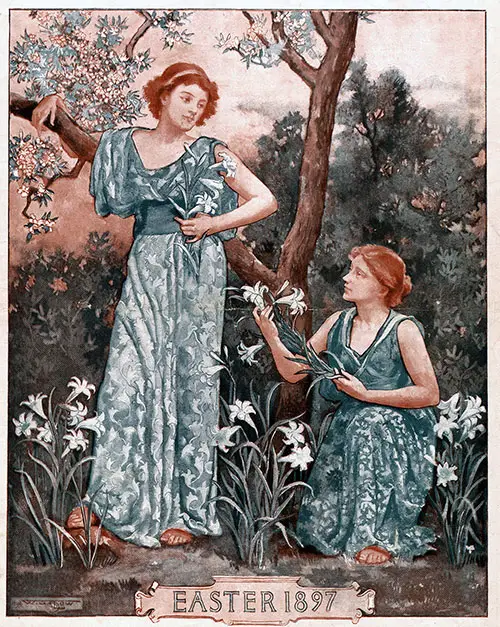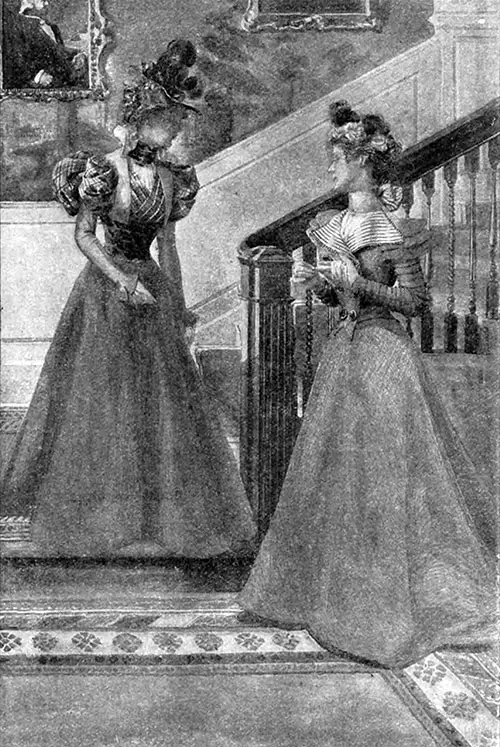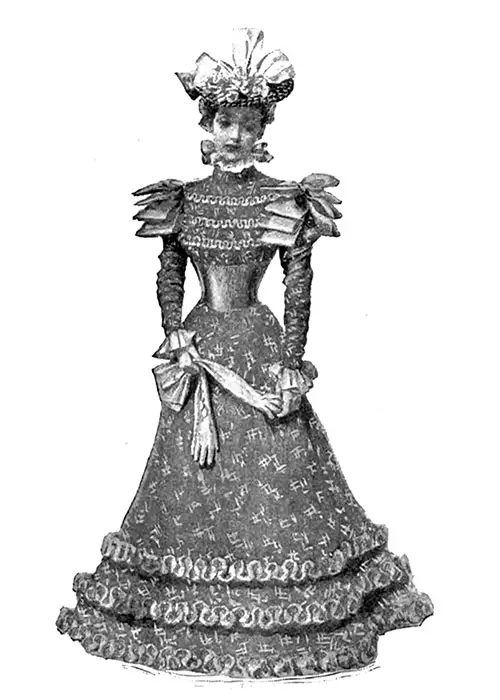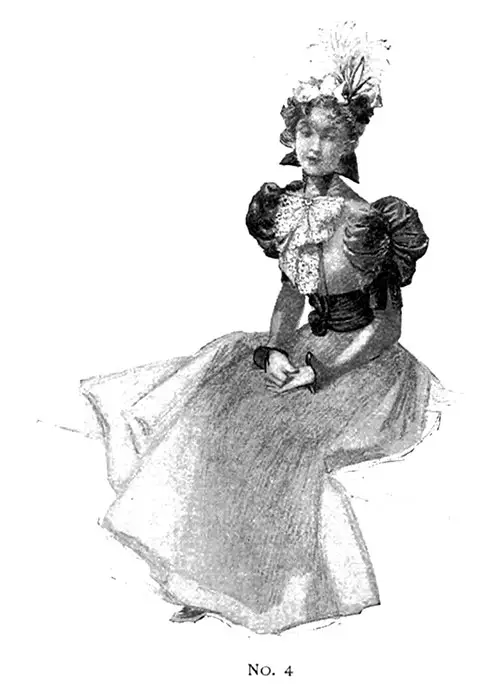New Easter Costumes for March 1897

By Isabel A. Mallon
With Illustrations by Elizabeth Shippen Green
The materials shown for the early Easter costumes range from the smooth cloths and mixed suitings down to the lovely lightweight silks, heavier striped moirés, and Miroir effects in wool. The suitings in checks show the combined effect caused by the skillful intermingling of many threads of different colors.
They are also in the plain shades of mode, steel blue, silver gray, heliotrope, cadet, and the many other colors that are approved for spring wear. In the smooth cloths the rather bright green known as emerald, a somewhat deep but still a bright blue, Reseda, and, of course, black, are noted.
Silks in the plain colors are almost entirely used for skirts; another silk, figured or striped, but in harmony, forming the bodice or jacket basque. The bolero jacket, despite the popularity given it during the winter, will obtain for the spring costumes.
Sleeves are fitted to the shape of the arm with great care. They are invariably trimmed—most often on the shoulders, but quite as often the trimming is placed about each wrist to harmonize with the shoulder trimming. Lace and chiffon may be said to lead in the spring decorations.
The trimmed skirt is a certainty, but skirts are not as wide, fit smoothly about the hips, and have the necessary spring starting from just above the knees.

Nos. 1&2: Dainty Costume and Wool Costume
The Fashionable Combinations
A dainty costume (No. 1) which displays a favored combination, is of smooth gray cloth; the gray, while it is light, is yet a little deeper in tone than the tint known as dove color.
The skirt is fitted over the hips tightly, and suggests that it fasten there, as on each side, and extending for the distance of a quarter of a yard below the waist, are two narrow revers of the cloth, each turning toward the back and fastened by worked buttonholes, not imitation ones, over five small, but glittering, steel buttons.
The bodice shows just below the neck a folded vest of white chiffon, which is only visible as a V-shaped section, for over this is another of blue and green plaid silk. Around the waist is a high folded belt, also of the plaid silk.
The jacket is of the cloth, in shape a square Eton, quite short, really just reaching to the top of the belt. It is finished with two rows of fine stitching. The folded stock is of the plaid silk with a large “fluff” bow of the chiffon at the back. The sleeves fit the arms smoothly and closely and have at the top of each a butterfly puff of plaid silk.
They are quite long and have at the wrists tabs of the cloth lined with plaid silk that extend while they flare far over the hands, making them look, as such sleeves always do, very tiny.
The hat is a large one of gray straw decorated with high loops of green and blue plaid ribbon and a bunch of green cock's feathers.
The gloves are a light gray suede and close with the usual large buttons. This combination of gray with the blue and green plaid is a somewhat unusual one, but all of the most artistic dressmakers approve it.
Some Other Costumes
Another wool costume (No. 2) is of mixed suiting, the material being composed of brown, white and red threads, the brown exceeding all in quantity, so that a brown effect is achieved, with, here and there, touches of red or white.
The skirt fits well and is the usual sensible length, just escaping the ground. The bodice is a short, double-breasted basque; it arches over the hips and is cut in the back and front in two tiny points.
The buttons used for the closing are large tortoise-shell ones. Just above the bust-line the basque is turned back in revers fashion and faced with brown and white striped moiré, the revers being outlined with narrow piping of brown cut beads.
A pale blue chiffon gilet shows between the revers. The high collar is a perfectly plain one of white moiré, while at the back is an enormous bow made of the silk like that used for facing the revers.
The sleeves are close-fitting and are laid in little tucks, which look like pipings, from the wrists to the shoulders.
The trimming at each shoulder consists of three overlapping caps of the striped silk. These are shaped so that they fit around the sleeves, and although there are three of them, they are so precisely cut and placed that they droop and stand out rather than up.
A brown straw bonnet, trimmed with white flowers and brown tips, with three or four turquoise ornaments as color contrasts, gives the finishing touch to a brilliant costume. The gloves are white glacé kid, and the parasol is of striped silk.
A Costume of Summer Silk

A stylish costume (No. 3) that is somewhat brighter in color and lighter in weight, is made of summer silk; it is the favorite blue shade, and has upon it, in white, those queer geometrical designs that look like the Chinese alphabet.
The skirt has three rows of quilted white satin ribbon about it; the first is on the extreme edge, and between the rows is, at least, an eighth of a yard. The bodice is around one, and has, across the front, three rows of narrow white satin ribbon quilled like those on the skirt, the space between being just enough to show the contrast afforded by the decoration.
A fitted belt of white satin, adequately boned, is at the waist. The collar is of silk and quite smooth; a flaring double box-plait of the satin ribbon is at each side, somewhat nearer the back than the front, and stands out well in a flaring fashion.
Over the edge of the collar, in front, is a fall of narrow lace. The sleeves are wrinkled in mousquetaire fashion, and have, at the top of each, large bows of the ribbon.
Each bow shows four large loops on each side, but as they are drawn in very close at the center under a small Rhinestone buckle the undesirable “bunchy’’ effect does not appear.
The wrists are finished with plaited frills of the ribbon that flare well over the hands. A blue hat, which is trimmed with white velvet roses and white satin ribbon, is proper with this gown, while the parasol, made of the dress material, with a natural wood handle, is a smart adjunct. White glacé gloves are chosen for wear with this costume.
A Smart Gown

A typical costume (No. 4) showing the fancied use of velvet is of tan broadcloth. The skirt is quite plain; the bodice is tightly fitted to the figure in the back and has short, square tails that are cut off sharply so that it arches over the hips.
In front, the bodice proper is a square Eton jacket, reaching just below the bustline, and showing a full blouse front of pale pink chiffon. A high belt of green velvet is folded across the front and drawn down in the center under a box-plaited bow of the velvet.
The sleeves are of the cloth, and fit the arms closely down to the wrists, where they flare broadly, and as a finish are piped with green velvet.
The trimming on each is a butterfly puff of the velvet, which is shaped in like a close-fitting sleeve, slashed on the upper part and fitted over the arm almost to the elbow.
The collar, a folded one, is of the chiffon with points of the velvet overlapping it and caught down flat at each side of the front, while at the back there is a high velvet collar that stands out in a flare at each side.
A jabot of lace is fastened just at the center of the collar in front by a brooch of bright stones; it extends some distance below the bust-line, giving a beautiful fullness to the figure, and forming a decided contrast to the cloth of the Eton jacket on each side of it.
The bonnet worn with this costume is constructed of pink rosebuds and green leaves with high loops of rose-colored ribbon and osprey feathers.
In trimming a gown with velvet—that is, a gown intended for spring wear—care must be taken to have the velvet properly cut and fitted. To achieve the desired effect with velvet one needs to consider, not only the figure of the wearer but also her complexion and the color of her hair.
Mallon, Isabel A., “The New Easter Costumes” illustrated by Elizabeth Shippen Green, in The Ladies Home Journal, Philadelphia: The Curtis Publishing Company, Vol. XIV, No. 4, March 1897, p. 20.
Note: We have edited this text to correct grammatical errors and improve word choice to clarify the article for today’s readers. Changes made are typically minor, and we often left passive text “as is.” Those who need to quote the article directly should verify any changes by reviewing the original material.

